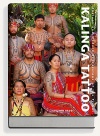Kalinga Tattoo (book)
| Author | Dr. Lars Krutak |
|---|---|
| Illustrator | |
| Genre | Photography |
| Country | Germany |
| Publisher | Editions Reuss |
| Published | October 1, 2010 |
| Language | English, German |
| Pages | 424 |
| ISBN | 3934020860 |
Kalinga Tattoo: Ancient & Modern Expressions of the Tribal is a photographic masterpiece that explores the vanishing art of Kalinga tribal tattooing in the remote mountains of the northern Philippines. Combining the visionary talents of numerous international photographers and the words and stories of nearly fifty Kalinga elders, Kalinga Tattoo is the first book to tell the story of this incredibly rich tradition of indigenous body art that is believed to be 1,000 years old. Here’s a rare trove of tattoo motifs, variations and interpretations which can reveal new perspectives for every interested tattooist.
The journey begins with tattoo anthropologist Dr. Lars Krutak’s first encounter with the last Kalinga tattoo artist, the 91-year-old Whang-Od, and is followed by the moving poetry and song of tattooed Kalinga author and elder Natividad Sugguiyao. Sugguiyao’s narratives provide an insider’s perspective regarding the history and significance of Kalinga batok (tattoo), and they establish new ways of reading the messages encoded in this ancient art form of the skin.
Krutak continues with an historical exploration entitled HISTORY OF KALINGA TATTOO ART that focuses on those cultural institutions that were deeply intertwined with Kalinga tattooing itself. Dramatic images of tattooed men and women taken over the last 100 years and colorful village scenes and landscapes accentuate the chapter.
Lars’ detailed study into the significance of Kalinga tattooing proceeds with an illustrated discussion of the artistic motifs that comprise Kalinga tattoo art. This chapter, KALINGA TATTOOING MOTIFS, is an absolute must read for anyone seeking knowledge (spiritual or otherwise) of the real roots of tribal tattooing practices that are largely disappearing around the world today.
Because warrior culture, headhunting, and religious ritual permeated nearly every facet of Kalinga tattooing practice, WARRIOR CULTURE OF THE KALINGA focuses on these customs. Krutak recounts his experiences with Kalinga warriors (old and new) and breathes life into long-forgotten Kalinga literature revolving around human sacrifice and other ceremonies associated with the human hunt. The nature of the research is outstanding and wonderfully detailed, and the words (and actions) of his Kalinga informants are truly unforgettable. What follows these texts is a remarkably beautiful photographic exhibition of the last generation of Kalinga warriors in vivid color who earned their tattoos on the field of battle.
THE LAST KALINGA TATTOO ARTIST looks at the life and work of Whang-Od, the last Kalinga mambabatok or tattooist, who dedicated her life to the art of her ancestors. Krutak, who lived with the master artisan for nearly two weeks, exposes for the first time in history the biography of this unique woman who for more than seventy years has plied the skins of countless generations of Kalinga men and women with thorns and other natural tools.
Finally, MARK OF THE FOUR WAVES TRIBE documents the artistic achievements of a growing number of young Filipino-Americans who since 1998 have each made a conscious individual effort to revive the indigenous tattooing traditions of the Kalinga and other tribal peoples of the Philippines. Whether through hand-tapping, hand-poking, or machined work, the Tribe’s dedication to “The Movement” has resulted in the revitalization of timeworn tribal designs with new design concepts that are beginning to approach the longstanding accomplishments of Polynesian artists who guided the tattoo renaissance across the Pacific in the early 1980s. For Krutak and Sugguiyao, the Tribe represents the very best of contemporary tribal tattoo culture because they dynamically express the enduring strength of time-tested indelible traditions that firmly anchor indigenous and modern concepts of identity on the skin for all to see.
